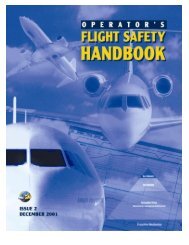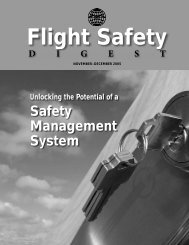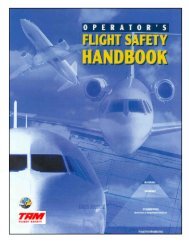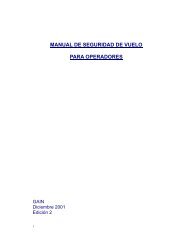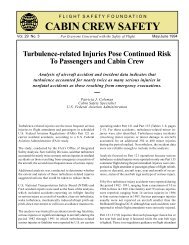Basic Aviation Risk Standard Resource Sector - Flight Safety ...
Basic Aviation Risk Standard Resource Sector - Flight Safety ...
Basic Aviation Risk Standard Resource Sector - Flight Safety ...
Create successful ePaper yourself
Turn your PDF publications into a flip-book with our unique Google optimized e-Paper software.
Threat 6.0: Incorrect Loading<br />
Incorrect loading of passengers and/or their lack of proper safety awareness<br />
results in an aircraft accident<br />
Control 6.1: Passenger Weight<br />
12<br />
Threat Controls<br />
Threat 6.0:<br />
Incorrect Loading<br />
For fixed wing aircraft with a maximum gross take-off weight<br />
(MGTOW) less than 5700kg, and all helicopters regardless of<br />
MGTOW, actual body weight (including hand luggage) is to<br />
be used.<br />
If within regulatory and operator operating guidance, standard<br />
weights based on seasonal averages acceptable to Company<br />
may be used for fixed wing aircraft with a MGTOW exceeding<br />
5700kg unless aviation specialist advice provides alternative<br />
guidance.<br />
Control 6.2: Cargo Weight<br />
All baggage and cargo will be weighed separately and appear<br />
on the manifest and measures are to be taken to ensure that<br />
effects of rain do not alter the weight prior to loading. Cargo<br />
will not normally be carried inside the passenger compartment<br />
during passenger carrying operations. Should it be necessary,<br />
the cargo must be adequately secured using nets and straps,<br />
and must not obstruct normal or emergency exits and where<br />
practical should be placed forward of the passengers.<br />
Control 6.3: Weight and Balance Calculations<br />
Prior to take-off the Pilot-in-Command (PIC) is to ensure that<br />
fuel and oil requirements are correct, and that weight and<br />
centre of gravity limits of the aircraft have been calculated<br />
and are within limits for flight. Use of an approved load-sheet<br />
is acceptable for use and must be available in the cockpit<br />
at all times.<br />
Control 6.4: Manifest<br />
Passenger Weights<br />
Cargo Weights<br />
Weight & Balance<br />
Calculations<br />
A passenger manifest is to be raised for each flight or, where<br />
applicable, each sector. At a minimum the passenger’s full<br />
name shall be recorded. The manifest shall always accurately<br />
reflect the occupants of an aircraft when in flight, and a copy<br />
must be accessible by flight following personnel at all times.<br />
Manifest<br />
Dangerous Goods<br />
Control 6.5: Dangerous Goods Cargo<br />
(Hazardous Materials)<br />
Carriage of dangerous goods is to comply with current<br />
International Air Transport Association (IATA) guidance<br />
(or similar guidance such as Title 49 of the Code of Federal<br />
Regulations) associated with Dangerous Goods Regulations.<br />
The aircraft operator shall have appropriate procedures<br />
and trained personnel for the carriage and acceptance of<br />
dangerous goods. All aircrew are to have completed dangerous<br />
goods awareness training at intervals not exceeding two years.<br />
Control 6.6: Passenger Briefing<br />
Passengers shall be briefed on emergency procedures and<br />
safety matters prior to flight. Minimum briefing requirements<br />
must include:<br />
• No smoking around the aircraft and apron area, or at any<br />
stage during flight<br />
• General description of aircraft and specific avoid/danger<br />
<strong>Flight</strong> SaFety Foundation BaSic aviation RiSk StandaRd – <strong>Resource</strong> <strong>Sector</strong> © version 3<br />
areas<br />
• Location of non-smoking and fasten seatbelt signs and<br />
briefing cards<br />
• Use of seat belts and shoulder harnesses<br />
• Location and operation of oxygen masks, if applicable<br />
• Means of communication between crew and passengers and<br />
the BRACE position<br />
• Location and use of normal and emergency exits and all life-<br />
saving equipment<br />
• Guidance on the use of Personal Electronic Devices (PEDs).<br />
Control 6.7: Multi-language Briefing<br />
Passenger Briefing<br />
Multi-language<br />
Briefing<br />
When the first language in the area of operations is not<br />
English, the aircraft operator is to provide emergency exit<br />
decals and briefing in the local language as well as English.


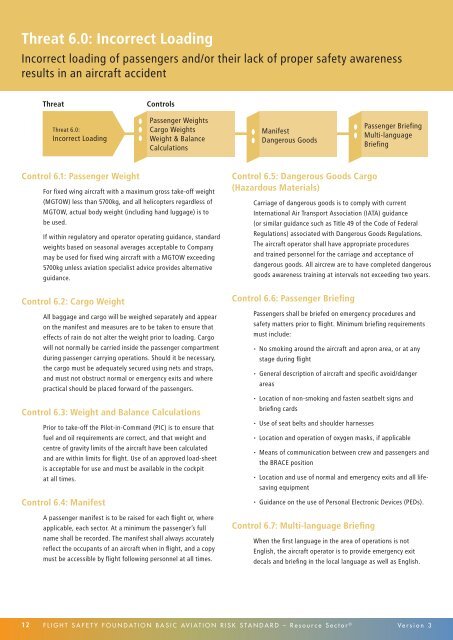

![Download this Issue [PDF 7 MB] - Flight Safety Foundation](https://img.yumpu.com/18859635/1/190x245/download-this-issue-pdf-7-mb-flight-safety-foundation.jpg?quality=85)
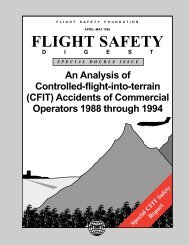
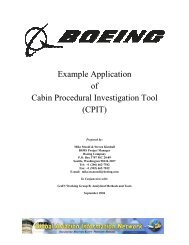
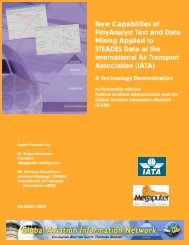
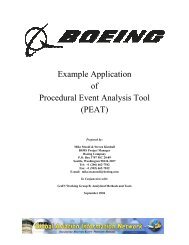
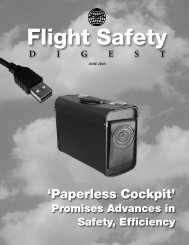
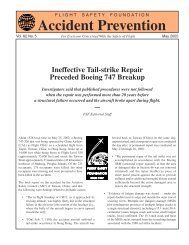
![Download [PDF 8 MB] - Flight Safety Foundation](https://img.yumpu.com/18859366/1/190x245/download-pdf-8-mb-flight-safety-foundation.jpg?quality=85)
